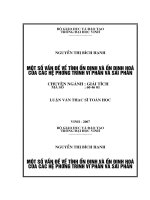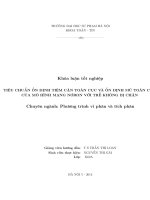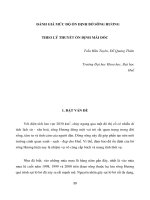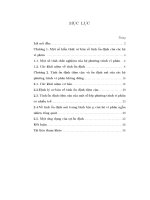Các vấn đề đối mặt với sự ổn định của Iran thách thức kinh tế và phong trào thanh niên
Bạn đang xem bản rút gọn của tài liệu. Xem và tải ngay bản đầy đủ của tài liệu tại đây (44.42 KB, 10 trang )
Swan 1
Problems Facing Iran’s Stability: Economic Challenges and the
Youth Movement
Iran is facing several unique challenges today in relationship to
economic development, democratization, and defining their national
identity. The reason these challenges are at hand are primarily due to
two outstanding issues: the nation’s poor economic conditions and the
creation of a youth baby boom after the 1979 revolution that
established their current theocratic government.
The Iranian economy has been lackluster in the 21 st century.
Hossein Abbasi-Nejad, the Associate Professor of Economics at
University of Tehran, has written a comprehensive article on Iran’s
economy in the beginning of twenty first century. In the article AbassiNejad points out that “In [sic] past five years, the rate of growth of real
GDP has been 7.6, 6.8, 4.8, 5.4, and 4.7 percent, respectively. …
Although the rate of economic growth has been higher in Iran
compared to [sic] last three decades, it is not high enough to offset
Iran’s bad economic performance in three decades. In fact, Iran needs
1
Swan 2
higher sustained economic growth to reduce its gap from developed
and even some developing countries.” Abassi-Nejad attributes the poor
economy to several key factors: federalizing businesses after the
revolution, failed supply-side government policies, and the volatility of
the oil markets.
International pressures due to the Iranian nuclear
program have cast a pall over future economic growth; therefore
foreign investment could trend downward, further having a negative
impact on the Iranian economy.
Obviously, the political-economic impact on Iran regarding its
nuclear program and the implications of current and further sanctions is
a serious matter that requires understanding of the various motivating
factors in Iran’s creation of a (supposedly peaceful) nuclear program.
One must understand that the majority of Iran’s population is
comprised of a younger demographic. Major Brendan Harris, in his
paper on Iran’s expanding youth population and the national security
implications on the United States, points out that the “youth bulge” has
serious short-term and long-term implications on the Iranian economy,
especially since it is estimated that the Iranian unemployment rate is at
2
Swan 3
least 14 percent. The long-term economic impact, specifically relating
to the nuclear issue at hand, is that Iran will have a need for an increase
in energy output to keep up with the expanding population’s
consumption. That being said, Iran could have a legitimate nuclear
energy need.
However, without providing access to their nuclear
program sites to the IAEA, it is not apparent that their intentions are
truly peaceful.
The conundrum that Iran has is that they cannot
continue to isolate themselves from the global community, either
politically or economically. If their population continues to expand,
they continue to have such high unemployment rates, and they continue
to inspire UN Security Council economic sanctions, their faltering
economy could motivate their young population to revolt and install a
new form of government similar to the events of the Iranian Revolution
in 1979.
Regarding the political environment and national identity of Iran,
behind these matters lies the growing youth population which seeks a
more open society that is both a regional leader and a legitimate voice
in the international stage. The economy continues to embolden the
3
Swan 4
youth to pressure the political infrastructure to evolve; though most
would gather that true political changes are not occurring – at least at
the pace that the youth movement would prefer. The expanding youth
population calling for reform and the controversial nuclear program
strongly impacts their politics and national identity. Their national
identity is a dichotomy: leadership being an oppressive theocracy based
on repression and a youth movement seeking change. The opposing
factions have created tensions that continue to show a national identity
going in two separate directions.
In conclusion, the biggest challenge facing Iran between the
above three issues (national identity, liberalization, and the economy)
would appear to be the Iranian national identity as it impacts both their
political infrastructure and their economy.
The two contrasting
cultures, the status quo infrastructure vs. the bourgeoning youth
demographic, continue to push and pull the national identity between
one of reform and one of hard-line religious leadership. If the hardliners win this struggle, Iran is on a path toward international
confrontation, which may impact their economy and national security
4
Swan 5
negatively. If the youth movement wins the day, there could be a new
path of openness with the world that may positively impact this isolated
Middle Eastern nation-state.
5
Swan 6
Works Cited
Abbasi-Nejad, Hossein. “Iran’s Economy in the beginning of twenty
first century-Part II.” H.A.N.D. Research Foundation. Published
Date is Unknown. />id=8, 15 Dec. 2008.
Babael, Hamid. “Iran's energy needs will not be met by oil alone.” The
Guardian.
20
Jan.
2006.
/>
accessed
16 Oct. 2008.
Campbell, Kelly. “Is Iran Facing an Economic Crisis.” United States
Institute
of
Pease.
May
2007.
/>nomic_crisis.html, accessed 16 Oct. 2008.
DNI. “Iran: Nuclear Intentions and Capabilities.” National Intelligence
Estimate
(NIE).
3
Dec.
2007.
/>accessed 30 Sep. 2008.
6
Swan 7
Fathi, Nazila. “Iran: the next revolution? Iran's population is mostly
young, educated, and frustrated with the country's social
restrictions. And they're starting to make noise.” BNET Business
Network.
10
Jan.
2003.
/>090, accessed 16 Oct. 2008.
Harris, Brendan M., Major, USAF. “IRAN’S YOUTH BULGE AND
ITS IMPLICATIONS FOR U.S. NATIONAL SECURITY
[PDF].” Air Command and Staff College, Air University. Apr.
2006.
/>
fc56-4ccb-8dfe670c0822a153/q_act_downloadpaper/q_obj_45d71918-302b4bd9-b39e-a82555bbb992/display.aspx?rs=enginespage, accessed
16 Oct. 2008.
“Iran:
Energy
overview.”
BBC
News.
15
Feb.
2006.
accessed16
Oct. 2008.
7
Swan 8
Kellogg, Amy. “Inside Iran Part II: The Younger Generation.”
FoxNews.
24
Nov.
2005.
accessed
16 Oct. 2008.
Levitt, Matthew and Peter Crail. “Can Sanctions Be Effective in
Halting Iran's Nuclear Program?” 19 Oct. 2007. Council on
Foreign
Relations.
/>
accessed 16 Oct. 2008.
Rivlin, Paul. “IRAN'S ENERGY VULNERABILITY.” MERIA:
Middle East Review of International Affairs. Dec. 2006.
/>accessed 16 Oct. 2008.
“UN approves new Iran resolution.” BBC News. 28 Sep. 2008.
accessed 16 Oct.
2008.
United Nations Security Council. “SECURITY COUNCIL DEMANDS
IRAN SUSPEND URANIUM ENRICHMENT BY 31 AUGUST,
OR
FACE
POSSIBLE
ECONOMIC,
DIPLOMATIC
8
Swan 9
SANCTIONS.”
UN.org.
31
Jul.
2006.
/>accessed 16 Oct. 2008.
United Nations Security Council. “SECURITY COUNCIL IMPOSES
SANCTIONS ON IRAN FOR FAILURE TO HALT URANIUM
ENRICHMENT, UNANIMOUSLY ADOPTING RESOLUTION
1737
(2006).”
UN.org.
23
Dec.
2006.
/>accessed 16 Oct. 2008.
US Department of State, Bureau of International Security and
Nonproliferation. UN Security Council Resolution 1803 on Iran's
Nuclear
Program.
State.gov.
4
Apr.
2008.
accessed 16 Oct.
2008.
Whittington, James. “Youth shapes Iran's economy.” BBC News. 3
Dec.
2002.
/>
accessed 16 Oct. 2008.
9
Swan 10
“The
Youth
Boom
in
Iran.”
niacINsight.
10
Jan.
2008.
accessed 16 Oct. 2008.
10








